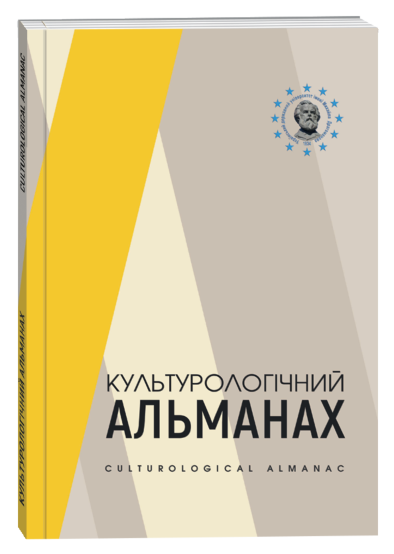КОНТЕМПЛЯТИВНІ СТУДІЇ: СТАН І ПЕРСПЕКТИВИ ГАЛУЗІ
DOI:
https://doi.org/10.31392/cult.alm.2023.2.23Ключові слова:
філософія, епістемологія, контемплятивні студії, контемплятивні практики.Анотація
У статті розглянуто основні аспекти нової галузі – контемплятивних студій. Це галузь, яка поєднує у собі інтереси прикладних і гуманітарних наук, відіграє роль майданчика для співпраці, обміну знаннями та досвідом поміж дослідниками із різних дисциплін: когнітивних наук, нейронаук, медицини, філософії, педагогіки, психології, культурології, релігієзнавства тощо. Історія галузі зумовлена кількома важливими етапами: діалогом релігійних і духовних традицій світу (кінець XIX ст.), змінами і імміграційною політикою на Заході у XX ст., посиленням уваги до східних духовних практик і трансляції цих практик завдяки живим носіям із Азії. Зрештою, у науці формуються осередки дослідників медитації, йоги та інших феноменів, які нині узагальнюються під спільним поняттям контемплятивних практик. Можна умовно виділити дві великі гілки у наукових дослідженнях: контемплятивну науку (коґнітивні студії, нейронауки, медицина тощо) і контемплятивні студії (переважно гуманітарна освіта). У статті також проаналізовано основні поняття та ідеї, які застосовуються методологічно фахівцями галузі: «контемпляція», «контемплятивні практики», «досвід» (від першої, другої та третьої особи). Нові методології у навчанні мають на меті побудувати довіру до суб’єктивного досвіду, створити сприятливе освітнє середовище діалогу між практиками і формування на основі цих двох попередніх кроків ширшої, поглибленої ціннісно та осмисленої картини світу. Основними перспективами контемплятивних студій є створення освітніх форматів, які включають особистий досвід, навички створення спільного поля смислів і далі на основі втіленого пізнання краще розуміння природи свідомості людини. Надалі ці відкриття мають застосовуватися у філософії, на практиці у мистецтві та інших креативних формах реалізації людини.
Посилання
Barbezat, D.P., & Bush, M. (2013). Contemplative Practices in Higher Education: Powerful Methods to Transform Teaching and Learning. 1st edition. Jossey–Bass.
Burggraf, S. (2007). Contemplative Modes of Inquiry in Liberal Arts Education.
Coburn, T., Grace, F., Klein, A., Komjathy, L., Roth, H., & Simmer-Brown, J. (2011). Contemplative Pedagogy: Frequently Asked Questions. Teaching Theology & Religion, 14, 167–174. Retrieved from: https://doi.org/10.1111/ j.1467–9647.2011.00695.x.
Farias, M., Brazier, D., & Lalljee, M. (2022). The Oxford Handbook of Meditation. Oxford University Press.
Brown, C.G. (2021). Meditation and Education. / In M. Farias, D. Brazier, & M. Lalljee (eds.). The Oxford Handbook of Meditation (969 р.). Oxford University Press. Retrieved from: https://doi.org/10.1093/oxfordhb/9780198808640.013.40.
Grossenbacher, P.G., & Rossi, A.J. (2014). A Contemplative Approach to Teaching Observation Skills. The Journal of Contemplative Inquiry, 1(1). Article 1. Retrieved from: https://journal.contemplativeinquiry.org/index.php/joci/article/ view/3.
Gunnlaugson, O. (2015). Contemplative Learning and Inquiry across Disciplines / E.W. Sarath, C. Scott, & H. Bai (eds.); Reprint edition. State University of New York Press.
Zajonc, A. (2014). Contemplative pedagogy in higher education toward a more reflective academy. Contemplative Learning and Inquiry Across Disciplines, 15–29.
Hart, T. (2004). Opening the Contemplative Mind in the Classroom. Journal of Transformative Education, 2(1), 28–46. Retrieved from: https://doi.org/10.1177/1541344603259311.
Komjathy, L. (ed.). (2016). Contemplative Literature: A Comparative Sourcebook on Meditation and Contemplative Prayer. Reprint edition. State University of New York Press.
Komjathy, L. (2017). Introducing Contemplative Studies. 1st edition. Wiley–Blackwell.
Matko, K., & Sedlmeier, P. (2019). What Is Meditation? Proposing an Empirically Derived Classification System. Frontiers in Psychology, 10, 2276. Retrieved from: https://doi.org/10.3389/fpsyg.2019.02276.
Roth, H. (2006). Contemplative Studies: Prospects for a New Field. Teachers College Record – TEACH COLL REC, 108, 1787–1815. Retrieved from: https://doi.org/10.1111/j.1467–9620.2006.00762.x.
Roth, H. D. (2008). Against Cognitive Imperialism. Religion East and West, 8. Retrieved from: https://www. academia.edu/5770211/Against_Cognitive_Imperialism_A_Call_for_a_Non_Ethnocentric_Approach_to_Cognitive_ Science_and_Religious_Studies_1.
Shapiro, S.L., Brown, K.W., & Astin, J. (2011). Toward the Integration of Meditation into Higher Education: A Review of Research Evidence. Teachers College Record, 113(3), 493–528. Retrieved from: https://doi. org/10.1177/016146811111300306.
Sherman, J. (2014). On the Emerging Field of Contemplative Studies and Its Relationship to the Study of Spirituality. Spiritus: A Journal of Christian Spirituality, 14, 208–229. Retrieved from: https://doi.org/10.1353/scs.2014.0031.
Simmer-Brown, J., Grace, F., & Komjathy, L. (2011). Meditation and the Classroom: Contemplative Pedagogy for Religious Studies. SUNY Press.
Sullivan, B. (n.d.). Liberal Arts Education and the Cultivation of Attention. Retrieved from: https://www.academia. edu/477480/Liberal_Arts_Education_and_the_Cultivation_of_Attention (December 16, 2022).
Wallace, B.A. (2000). The Taboo of Subjectivity: Towards a New Science of Consciousness. 1st edition. Oxford University Press.
Wit, H. (2017). On Contemplative Psychology. Philosophy Study, 7. Retrieved from: https://doi.org/10.17265/2 159–5313/2017.08.002.
Zajonc, A. (2006). Love and Knowledge: Recovering the Heart of Learning Through Contemplation. Teachers College Record, 108, 1742–1759. Retrieved from: https://doi.org/10.1111/j.1467–9620.2006.00758.x.








